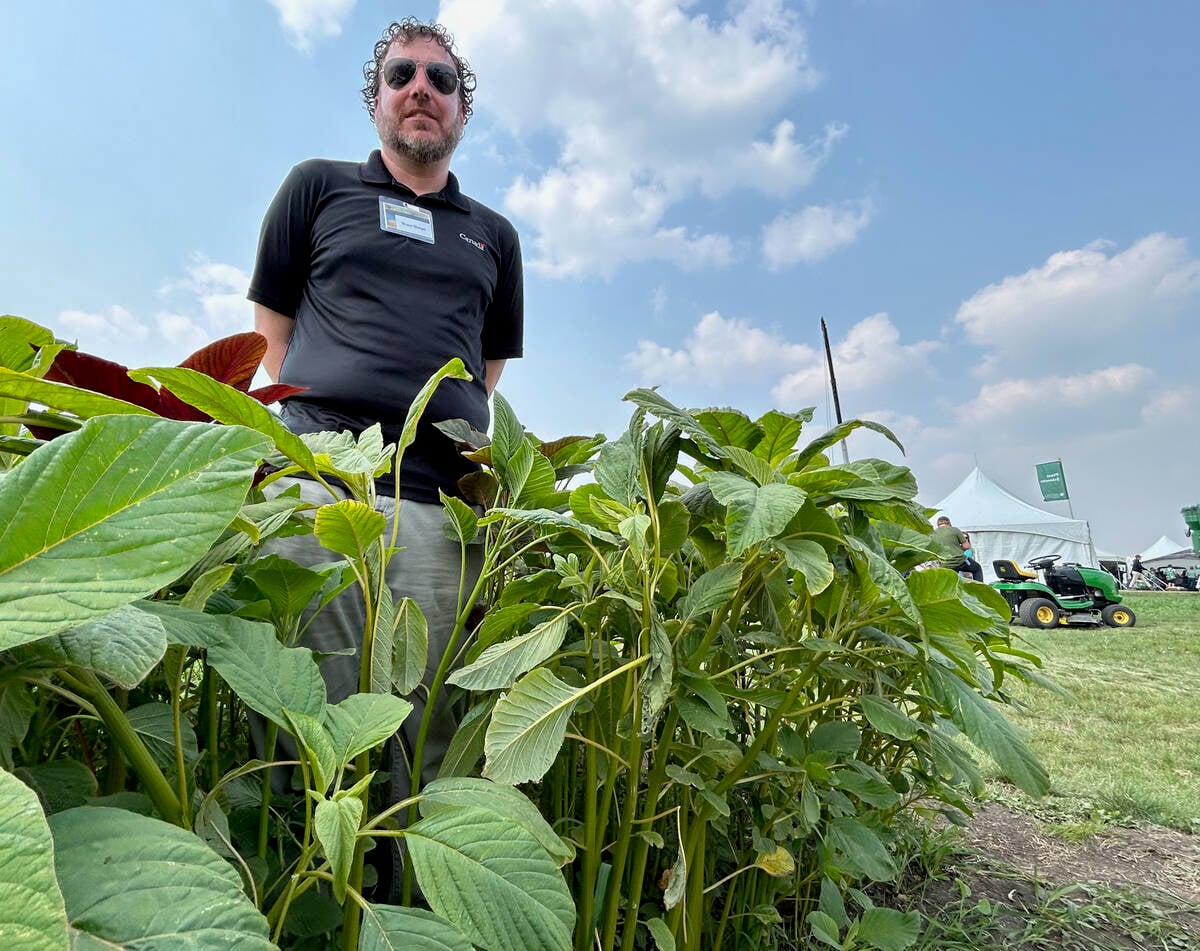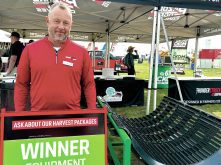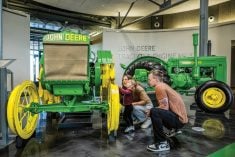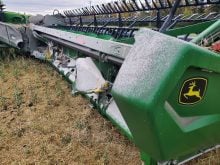Combine grain loss is a fact of life for most canola growers on the Canadian Prairies. A recent study conducted by the Prairie Agricultural Machinery Institute (PAMI) provided a snapshot of how significant those losses can be and what producers can do to reduce them.
The On-Farm Survey of Combine Grain Loss in Canola Across Western Canada involved in-field testing at 31 farms across Alberta, Saskatchewan and Manitoba from Aug. 22 to Oct. 18, 2019. A total of 50 combines, including 40 different models from six manufacturers, were analyzed as part of the project.
Lorne Grieger, PAMI’s director of technical sales, says the primary objective of the project was to gain a better understanding of actual canola combine losses and the variables that can affect those losses. A secondary goal of the study was to help educate producers on methods for effectively measuring their canola losses.
Read Also

Glufosinate-resistant waterhemp appears in U.S. Midwest
News of glufosinate-resistant kochia in the U.S. is concerning as farmers are losing options to control waterhemp, also of the pigweed family.
While there have been other studies conducted on the subject, Grieger says what made PAMI’s study different was the fact that several new varieties of canola and production techniques have been introduced in the intervening years and it had yet to be determined what effects they could have on combine losses.
During the in-field tests, drop pans provided by Bushel Plus and ScherGain were attached underneath each of the combines and dropped once the combines were operating to measure losses. Each loss test was repeated three times per combine to ensure accuracy. Canola seed collected in the pans was separated from the chaff and then weighed.
Overall, the results of the study measured an average combine loss of 1.3 bushels per acre or 2.8 per cent of yield. That included a minimum loss of 0.2 bushels per acre (0.4 per cent of yield) and a maximum loss of 4.1 bushels per acre (10.7 per cent of yield).
As part of the study, investigators looked at several different variables to determine their potential effects on combine losses. That included harvest timing, ambient temperature, relative humidity, weather conditions, wind conditions, harvest practices (straight cut versus swathing), grain moisture content, ground speed, grain feed rate, combine settings and combine age.
Environmental effects
Grieger says one of the more interesting findings of the study was the effect ambient environmental conditions can have on combine grain loss.
According to the results, significantly lower losses were experienced with higher ambient temperatures — 0.8 bushels per acre (bu/ac) when the temperature was greater than 23 C compared with 1.4 bu/ac when the temperature was less than 23 C.
The study results also indicated that relative humidity can also play a significant role in determining canola seed loss. It showed significantly lower losses were experienced with lower relative humidity — 1.2 bu/ac when the relative humidity was below 45 per cent compared with 1.6 bu/ac when the relative humidity was 45 per cent or higher.
In addition, the results showed significantly lower losses were experienced during sunny harvest conditions compared with cloudy or partly cloudy conditions. Average losses during sunny conditions were 1.0 bu/ac compared with 1.1 bu/ac in partly cloudy conditions and 1.7 bu/ac in cloudy conditions.
“When it’s easier to thresh, we saw lower losses as a whole,” Grieger says. “It’s one factor that can be considered when the combine is being operated to what that condition is and, as a result, what are the potential losses and the adjustments that can be made to reduce losses as a whole.”
Ground speed
Ground speed was also shown to play a huge role in determining combine losses during harvest. The study results showed significantly lower losses were experienced with a slower ground speed. Losses were measured at 1.2 bu/ac at a ground speed of below 4.3 miles per hour compared with 2.2 bu/ac at speeds above 4.3 m.p.h.
“Ground speed was one of the factors that really stood out when we consider the ambient conditions and the type of methods used. It was over a bushel per acre difference,” Grieger says. “If you go slower, all things being equal, we saw losses were lower compared to a faster ground speed.”
Perhaps the most surprising result to come out of the study was the fact the age of a combine doesn’t automatically determine how much canola seed can be lost during harvest.

In fact, the study’s results indicated a well-set, older combine can outperform a poorly set, newer combine.
Combines manufactured between 1993 and 2005 had an average loss of 0.8 bu/ac compared with 1.5 bu/ac for those manufactured between 2006 and 2014 and 1.3 bu/ac for machines manufactured between 2015 and 2019.
“Technology isn’t necessarily a deciding factor,” Grieger says. “If you understand your machine regardless of age and it’s maintained well and set up properly, it can be very effective in terms of reducing losses in canola as a whole.”
Although the study showed that straight cutting resulted in slightly higher combine losses than swathing (1.5 bu/ac compared with 1.2 bu/ac), Grieger explains it was a fairly small sample size and more testing is required to provide a more complete picture.
Getting it right
Grieger says one of the biggest take-home messages from the project for producers is the importance of making sure combines are set up for the type of harvest methods they are using and with the environmental variables they are dealing with at a given time.
He also stresses it’s important for growers to take regular loss samples to set benchmarks, which will help them to determine what kinds of adjustments to their combines are necessary.
“You can’t control the weather, but you can control how you operate your machine and how you set it up,” he adds.
Funding for the study was provided by SaskCanola, Manitoba Canola Growers, Alberta Canola, the Canola Council of Canada (CCC) and the Canadian Agricultural Partnership.
Changing times
Shawn Senko, a CCC agronomy specialist, says it’s important for studies like the PAMI project to be conducted periodically to incorporate the latest innovations in technologies and methodologies used by growers.
“Over time, things like the canola cultivars change, their yields and traits change, and things like straight cutting come along and change the way canola flows through the combine. Then the machinery changes. That all has an effect on things, so it’s good to see what effect those changes have on losses,” he explains.
Senko adds one of the most important lessons to be learned from the study is the importance of getting out into the field and testing for combine losses.
“That’s the No. 1 thing. You can’t make any adjustments or correct anything if you don’t know where you are starting from,” he says.
“Once you have that baseline and know how things change through the day, you can make those adjustments and know you are correcting things.”
Codie Nagy farms 7,000 acres near the town of Ogema, Sask. Nagy read the study’s results online and while he didn’t find anything particularly surprising in the data, he thinks it was a worthwhile exercise.
“I think … just knowing that every type of combine has losses if not set properly is more useful than all of the other data generated out of research like that,” he says.
“It gets everybody thinking about what’s happening on their own farms. If they see there’s research being done showing there’s a large amount of losses regardless of the colour of the combine, I think that will push a lot of people into getting a drop pan to put behind their combine to accurately measure what they are losing.”
















